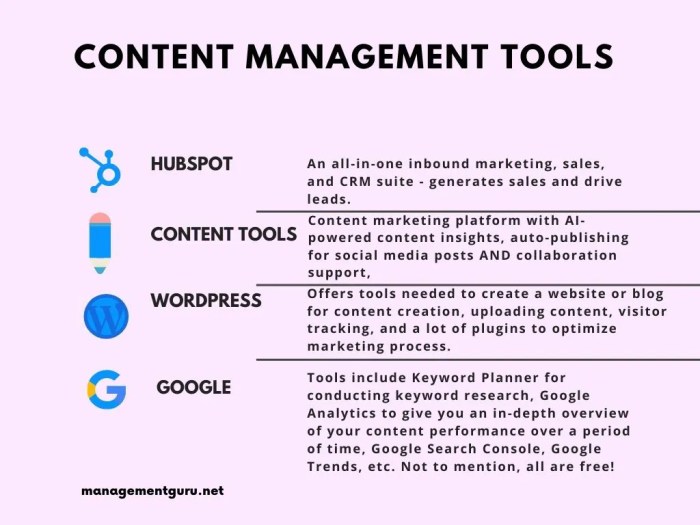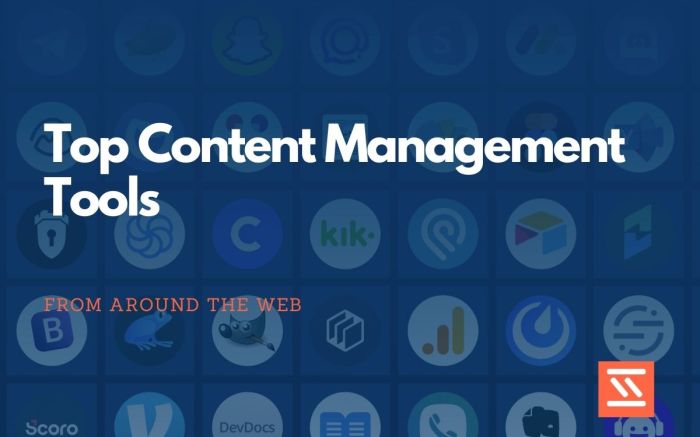Using Content Management Tools sets the stage for this enthralling narrative, offering readers a glimpse into a story that is rich in detail with american high school hip style and brimming with originality from the outset.
Content management tools have become essential for modern website development, providing a seamless way to create, organize, and optimize content. This guide delves into the various aspects of using these tools to enhance your online presence.
Introduction to Content Management Tools: Using Content Management Tools

Content management tools are software applications designed to help businesses create, manage, and publish digital content efficiently. These tools enable users to organize and control their content in a centralized system, making it easier to collaborate, streamline workflows, and maintain consistency across multiple platforms.
Benefits of Using Content Management Tools
- Improved Workflow: Content management tools allow teams to collaborate in real-time, track changes, and streamline the content creation process.
- Centralized Content: With a single platform to manage all content, businesses can ensure consistency in branding, messaging, and quality.
- Enhanced Security: These tools offer robust security features to protect sensitive information and prevent unauthorized access.
- Efficient Publishing: Content can be easily published across multiple channels, such as websites, social media, and email campaigns.
Popular Content Management Tools
WordPress:
A widely-used open-source CMS known for its flexibility and user-friendly interface.
Drupal:
A powerful CMS favored for its scalability and customization options.
Joomla:
Another popular CMS that offers a balance between ease of use and advanced functionality.
HubSpot:
A comprehensive marketing platform with integrated content management capabilities.
Magento:
Primarily used for e-commerce websites, Magento offers robust content management features for online stores.
Types of Content Management Tools
Content management tools come in various types, each offering unique features and functionalities to help businesses manage their content effectively. Let’s delve into the different types of content management tools available in the market.
Traditional CMS vs. Headless CMS
Traditional CMS, such as WordPress and Joomla, are all-in-one solutions that provide a user-friendly interface for creating, managing, and publishing content on websites. These platforms offer pre-designed templates and plugins to customize the website without much technical knowledge.On the other hand, headless CMS, like Contentful and Strapi, decouple the content storage and presentation layers, allowing developers to have more flexibility in delivering content across various platforms and devices.
This approach separates the content from the design, enabling faster and more efficient content delivery.
Cloud-Based Content Management Tools
Cloud-based content management tools, such as Sitecore and Adobe Experience Manager, offer the advantage of accessibility, scalability, and security. With cloud-based solutions, businesses can store and manage their content on remote servers, allowing for easy access from anywhere with an internet connection. These tools also provide automatic updates and backups, ensuring data security and reliability.
Open-Source vs. Proprietary Content Management Tools
Open-source content management tools, like Drupal and WordPress, are free to use and can be customized based on individual needs. These platforms have a strong community of developers contributing to updates and improvements regularly. On the other hand, proprietary content management tools, such as Kentico and Sitefinity, are licensed software that comes with a cost but offers dedicated support, advanced features, and security measures.
Using Content Management Tools for Website Development

Content management tools play a crucial role in streamlining website development by providing a user-friendly interface for managing website content, design, and functionality. These tools help developers and designers collaborate efficiently, manage updates seamlessly, and ensure consistency across the website.
CMS Platforms for Responsive Websites
Responsive web design is essential in today’s digital landscape to ensure optimal user experience across various devices. Content management systems like WordPress, Joomla, and Drupal offer built-in responsive themes and templates that automatically adjust layout and content based on the screen size. This eliminates the need for manual coding and testing, saving time and effort in creating responsive websites.
- WordPress, the most popular CMS platform, provides a wide range of responsive themes that adapt to different screen sizes, making it easier to create mobile-friendly websites.
- Joomla offers responsive design features and extensions that enhance the website’s responsiveness without the need for extensive coding.
- Drupal allows developers to build responsive websites with its flexible framework and responsive themes, ensuring a seamless user experience on all devices.
Role of Plugins and Extensions in Website Functionality, Using Content Management Tools
Plugins and extensions play a significant role in enhancing website functionality and adding new features to a website without custom coding. Content management tools offer a vast library of plugins and extensions that allow developers to integrate e-commerce solutions, social media feeds, contact forms, tools, and more to enhance user engagement and site performance.
Plugins like WooCommerce for WordPress, VirtueMart for Joomla, and Drupal Commerce for Drupal enable developers to add robust e-commerce functionalities to websites effortlessly.
- plugins like Yoast for WordPress, SH404SEF for Joomla, and Drupal Tools for Drupal help optimize websites for search engines, improving visibility and ranking.
- Social media plugins like ShareThis for WordPress, EasySocial for Joomla, and Social Media Integration for Drupal allow users to share content easily across various social platforms, increasing reach and engagement.
- Contact form plugins like Contact Form 7 for WordPress, RSForm! Pro for Joomla, and Webform for Drupal enable users to create custom forms and capture user data effectively.
Content Creation and Collaboration with CMS
Content management tools play a crucial role in facilitating content creation and editing for websites. These tools provide a user-friendly interface that allows users to easily create, edit, and publish content without the need for technical expertise.
Facilitating Content Creation and Editing
Content management tools offer a variety of features that make it easy for users to create and edit content. These tools typically provide a WYSIWYG (What You See Is What You Get) editor, which allows users to format text, add images, and embed multimedia content without needing to know HTML or CSS.
- Users can easily create new pages or posts by simply typing in the content and formatting it using the editor.
- Content management tools also allow users to schedule posts for future publication, making it easy to plan content ahead of time.
- Users can collaborate on content creation by assigning roles and permissions to different team members, ensuring that each contributor has the appropriate level of access.
Collaboration Features Offered by CMS Platforms
CMS platforms offer a range of collaboration features that make it easy for multiple contributors to work together on creating and editing content. These features help streamline the content creation process and ensure that all team members are on the same page.
- Users can leave comments on content drafts, providing feedback and suggestions for improvement.
- Version control features allow users to track changes made to content and revert to previous versions if needed.
- Workflow management tools enable users to assign tasks, set deadlines, and monitor progress on content creation projects.
Managing Multiple Contributors Using Content Management Tools
Managing multiple contributors can be challenging, but content management tools offer tools and features to streamline the process. By following best practices and utilizing the collaboration features of CMS platforms, teams can effectively work together to create high-quality content.
- Clearly define roles and responsibilities for each team member to avoid confusion and ensure accountability.
- Set up a content calendar to plan and organize content creation tasks, making it easier to track progress and deadlines.
- Provide training and support to team members to ensure they are comfortable using the CMS platform and understand how to collaborate effectively.
Content Organization and Optimization
Organizing and categorizing content is crucial for a website’s success. Content Management Tools (CMS) play a vital role in helping users efficiently manage their content and optimize it for search engines. Let’s delve into how CMS tools assist in content organization and the importance of optimization features.
Organizing Content with CMS
- CMS tools provide users with the ability to categorize content by topics, tags, and metadata.
- Users can create a hierarchical structure for their content, making it easier for visitors to navigate the website.
- By organizing content effectively, users can improve user experience and engagement on their website.
Optimization in CMS
- optimization features in CMS tools help improve a website’s visibility on search engines like Google.
- Users can optimize meta titles, descriptions, and s to make their content more search engine friendly.
- By utilizing tools within CMS, users can boost their website’s ranking and attract more organic traffic.
Metadata and Tags for Ranking
- Metadata, such as title tags and meta descriptions, provide search engines with information about the content of a page.
- Properly optimized metadata can lead to higher click-through rates and improved search engine rankings.
- Tags, including header tags and alt text for images, also play a role in optimization by providing additional context to search engines.
Security and Backup Measures in CMS
In the world of Content Management Tools, ensuring security and having reliable backup measures in place is crucial to safeguarding valuable content and data.
Security Features in CMS
- Authentication and Authorization Controls: CMS platforms offer user authentication and permission settings to control access levels.
- SSL Encryption: Secure Sockets Layer (SSL) encryption ensures data transmission between servers and users is encrypted for enhanced security.
- Firewall Protection: Many CMS tools come equipped with firewall protection to prevent unauthorized access and attacks.
Importance of Regular Backups
Regular backups are essential to prevent data loss in case of system failures, cyber attacks, or accidental deletion. Having a solid backup strategy ensures that content can be restored quickly and efficiently.
Best Practices for Securing Content in a CMS
- Update CMS Software Regularly: Keep the CMS platform updated with the latest security patches to address vulnerabilities.
- Strong Password Policies: Enforce strong password requirements for users to prevent unauthorized access.
- Limit User Access: Restrict access to sensitive content to authorized users only to minimize risks.
- Monitor and Audit Activity: Regularly monitor user activity and audit logs to detect any suspicious behavior or security breaches.
